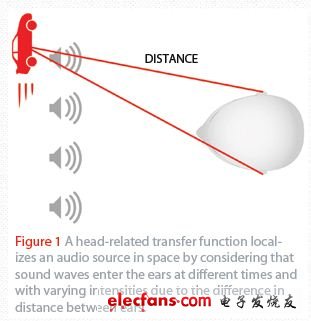prompt:
. The number of speakers and their spacing limit the sound field of a portable stereo system.
. Spatial audio attempts to artificially recreate the experience of listening to sound in the real world, or to establish a sensory spatial environment that does not actually exist.
. Using HRTF (Human Head Related Transfer Function) information, the binaural sound can be synthesized as if it came from any point in the space where the listener is located.
. The acoustic beamforming function directs sound waves in a certain direction instead of the typical radiation pattern of a speaker.
. Providing spatial stereo through a speaker array requires an effective crosstalk suppression algorithm.
. Many methods can provide spatial audio, but for any reasonable size on a small portable device, most of them are not suitable.
The sound field generated by a stereo sound system is usually limited by the physical location of the speakers, and the sound events received by the listener are limited by the span of the two speakers. For portable small audio systems, the stereo sound field experienced by users is very limited, almost mono. To overcome this limitation, you can use spatial audio vocalization technology to expand the stereo sound field, get better crosstalk suppression, and enhance certain spatial positioning performance.
Spatial audio
In a natural state, the sound around you is spatial in nature. The sound source is a point in a small area in the entire space, but some sound sources are from a wide area, such as earthquakes and landslides. The sound is reflected on various objects in the environment. What you hear is the direct sound and reflected sound of both ears. After some human hearing, the sound is finally recognized. You can make some judgments on the processed sounds, and use some signs to determine their characteristics, such as direction, position, loudness, background, quality, distance, tone, fullness or thinness. If there are two or more sound sources, you can also determine the mixing characteristics of each sound source relative to the total sound received by the ear.
The term spatial audio refers to the reproduction of sound using electronic or mechanical means. It attempts to artificially recreate the real world listening experience of sound. In addition, it also attempts to artificially change the reproduced sound to create a feeling space environment that may not exist.
The principle of spatial audio reproduction is simple: if the reproduced sound waves reaching the two ear drums are exactly the same as the real sound source at a certain location, you will feel the reproduced sound as if it were a sound source from that location. This has nothing to do with whether the sound source is sent from other locations. The sound data that reaches the ear is processed by the brain, and finally all aspects of the sound are specified.
HRTF
The ear's HRTF (Human Head Related Transfer Function) describes how you receive and process sound from a certain point in space. Frequency response HRTF describes how the human body gathers sound signals, and how the auricle (or external ear) and ear canal filter signals before the sound reaches the cochlea. The ring-shaped symmetrical outer ear (or pinna) constitutes a special-shaped antenna, so that the position-dependent and frequency-dependent filtered sound reaches the ear drum, especially the higher frequency sound.

Figure 1 The head-related transfer function considers that sound waves enter the human ear at different times and have different intensities due to the difference in distance between the two ears, thereby locating the sound source in space.
HRTF is the Fourier transform of the static measurement of the impulse response (or head-related impulse response) of the left and right ears of the sound received at different distances and directions. Both ILD (Binaural Sound Level Difference) and ITD (Binaural Time Difference) come from the sound heard by each ear (Figure 1).
Everyone's HRTF is different, because sometimes hearing and physical characteristics are significantly different. However, multiple HRTF measurement databases use general classification methods, such as male or female, and young or old, and are usually used in consumer audio applications that require HRTF. This measurement may take a lot of time, because people cannot hold their heads in a fixed position for a long time, so what they get is uncertain data. Therefore, some creators of HRTF data only measure the simulation head. This simulation head is a model based on the average human head and human ear to avoid errors in head movement.
Your ear can determine the direction of the sound in three dimensions, front / back, up / down, and sides, the angular resolution is about 3 °, and the distance can also be estimated, because your brain, inner ear, and outer ear will use Monophonic sound from one ear, compared with the stereo sound (or sound difference) heard by both ears. In a natural environment, individuals have learned the accuracy of their sound localization ability (ie their HRTF data) through multiple trial and error and life-long experiences, and can effectively compensate for the shape and composition of their bodies.
By applying appropriate filters to existing sound signals and combining the sound with HRTF information, it is possible to synthesize sounds that seem to come from any point in space, thereby obtaining left and right channel sounds specifically for each ear. Similar to the separation of left and right channels experienced by headset users, each ear only hears what it should hear. In comparison, the stereo audio signal played through the headphones seems to be limited to a line between the ears. This difference between native stereo and spatial audio produces 3D sound, or virtual sound.
Earphones Plug Wireless,Wireless Earphone,Earphones For Iphone,Earphone For Samsung,wireless bluetooth earphone
Shenzhen Konchang Electronic Technology Co.,Ltd , https://www.konchang.com